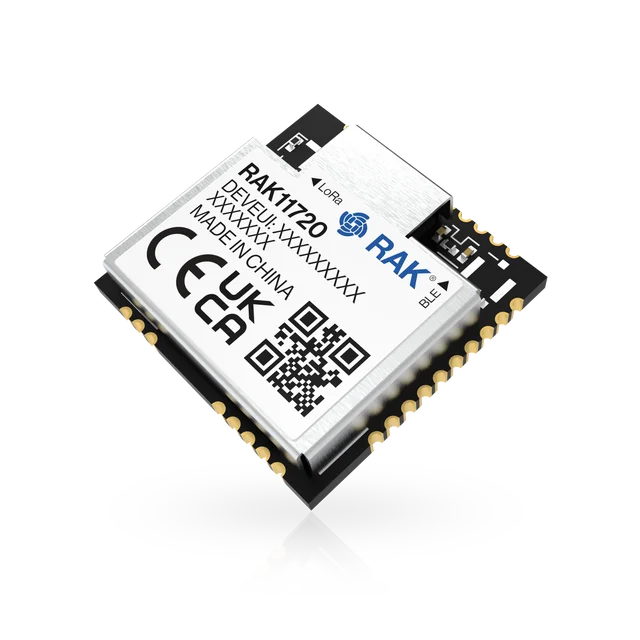RAK11720
The RAK11720 is a WisBlock Core module for RAK WisBlock. It is based on the powerful ultra-low power Apollo3 Blue SoC (AMA3B1KK-KBR-B0) from Ambiq together with a Semtech SX1262 LoRa® transceiver.
The AMA3B1KK-KBR-B0 has an integrated Bluetooth Low Energy transceiver that enhances the communication capabilities. The RAK11720 stamp module comes in the same size and footprint as our RAK3172 module which gives you the opportunity to enhance your existing designs with BLE without designing a new PCB.

Hardware
The easiset way to use a RAK11720, is the WisBlock Modular system. A WisBlock Base board (RAK19007) which provides the power supply and programming/debug interface is the base to plug a RAK11722 (WisBlock Core module with the RAK11720) in.
Apollo3 Blue SoC with up to 96 MHz operating frequency
ARM® Cortex® M4F core
16 kB 2-way Associative/Direct-Mapped Cache per core
Up to 1 MB of flash memory for code/data
Up to 384 KB of low leakage / low power RAM for code/data
Integrated Bluetooth 5 Low-energy controller
Semtech SX1262 low power high range LoRa transceiver
iPEX connectors for the LORA antenna and BLE antenna.
2 user LEDs on RAK19007 WisBlock Base board
Powered by either Micro USB, 3.7V rechargeable battery or a 5V Solar Panel Port
For more information about the RAK11720 stamp module:
Supported Features
The RAK11720 module configuration supports the following hardware features:
Interface |
Controller |
Driver/Component |
|---|---|---|
MPU |
on-chip |
arch/arm |
NVIC |
on-chip |
arch/arm |
SYSTICK |
on-chip |
systick |
STIMER |
on-chip |
stimer |
GPIO |
on-chip |
gpio |
UART |
on-chip |
serial |
WDT |
on-chip |
watchdog |
RADIO |
on-chip |
bluetooth |
RADIO |
on-board |
LoRa (SX1262) |
The default configuration can be found in the defconfig file:
boards/rak/rak11720/rak11720_defconfig.
Programming and Debugging
The RAK11720 board shall be connected to a Segger Embedded Debugger Unit J-Link OB. This provides a debug interface to the Apollo3 Blue chip. You can use JLink to communicate with the Apollo3 Blue.
Flashing an application
Connect your device to your host computer using the JLINK USB port. The sample application Hello World is used for this example. Build the Zephyr kernel and application, then flash it to the device:
# From the root of the zephyr repository
west build -b rak11720 samples/hello_world
west flash
Note
west flash requires SEGGER J-Link software and pylink Python module to be installed on you host computer.
Open a serial terminal (minicom, putty, etc.) with the following settings:
Speed: 115200
Data: 8 bits
Parity: None
Stop bits: 1
Reset the board and you should be able to see on the corresponding Serial Port the following message:
Hello World! rak11720/apollo3_blue